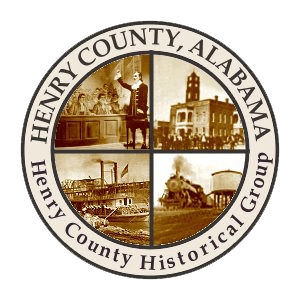
The very first transportation routes in the Alabama Territory and the newly formed Henry County, mainly followed old Indian paths. Early settlers entering the new lands, now Henry County, stayed close to Ft. Gaines, Georgia for protection from the Indians. There were no roads on which to venture into the unsettled wilderness. Among the early settlers that were settling just across the river in the first town in Henry County, Franklin, were Daniel Jackson and Matthew Jackson, brothers seeking a new life in a new land circa 1820. They had a third brother whose name is not known. It is said that brother lived to be 114 years old. Daniel and Matthew Jackson cut the very first road in Henry County and Southeast Alabama in 1820.
That first road ran from Franklin and Ft. Gaines to Prospect Bluff – 4 miles North of Franklin, to the present day Liberty Methodist Church, to Ray’s (later Richard’s Cross Roads), to present day Clayton (founded in 1820), to Williamson, to present day Louisville (founded in 1821) and on to Sparta in Conecuh County where the U.S. Land Office was located. This road followed on the south side of the Indian boundary line established in 1814 when the Indian Wars ended and the Indians were to stay north of this boundary line. This new road was crude and small in width. The importance of this road cannot be underestimated. It was a main factor in the early growth of Southeast Alabama until circa 1830. This first road was called the “Plank Road” because timbers and planks were laid down on parts of the road to make it passable for wagons. On March 3, 1821, the U.S. Congress passed an act establishing the first mail service in Henry and Southeast Alabama – from Franklin to Sparta using this road. Thousands of new settlers used the “Plank Road” as a passageway to points being settled as far away as Mobile. Traffic was heavy and trade was strong with both whites and Indians. This first Henry County Road also served as the first Stagecoach Route in 1821.
Daniel and Matthew also built the first house in Abbeville. This house was built of skinned pine logs and located where two Indian paths crossed and this spot began to grow. By 1823 this place was a growing village of substantial residents, being only 10 miles away from Franklin where settlers were pouring into the county. Daniel Jackson was born in S.C. in 1789. He died in Henry County, Alabama on Nov. 25, 1892. He is buried in the Mt. Zion Primitive Baptist Church Cemetery. This is the oldest active church in Henry County. Daniel was 103 years old, retaining his vigorous health and clear intellect until his death.
Daniel was married twice. His first wife was a Melton. They had 16 children. His second wife was Cynthia Odom. They had eight children. Some of his children lived in East Henry County and the Browns Cross Roads area.
Matthew Jackson was born in South Carolina. He died in 1890 in Henry County, Alabama. He is buried in the Balkum Cemetery. His tombstone read that he was 107 years old. His wife Mary died in 1916. They also have several children who are buried in the Balkum Cemetery. He was the grandfather of Nealy J. Jackson, who lived east of Tumbleton at Jackson Creek. Matthew also was the grandfather of Miss Mary Lizzie Jackson, now 101 years of age and is still going strong. Matthew Jackson also was the great, great grandfather of Mr. Raymond Jackson, who is presently head of the Headland Airport Authority, and also of Mrs. Beulah Jackson Morgan who works at Headland High School and lives at Tumbleton. Matthew Jackson had about seven children.
These Jackson brothers were real Henry County and Southeast Alabama pioneers. They opened up the first inroads that led to growth and expansion of this section. They were remarkable men. It’s a shame they don’t have a road named in their honor. These two early Jacksons owned homes in “Old” Franklin. Other Jacksons also settled in Franklin, no doubt being some of Daniel’s and Matthew’s kinship. A James Jackson was a buyer of property near Franklin, circa 1819, the same land that George Gamble first settled and planted the first crop on in Henry County in 1816. Mr. Benjamin C. Jackson owned 80 acres near Franklin later in 1832. A lot was sold in Franklin to Mr. Peter L. Jackson for $5.00 in 1822. Matthew Jackson was also the great grandfather of Mrs. Ann Jackson Hancock of Tumbleton. She is the only Jackson left that still lives on the old Jackson Place across Jackson Creek east of Tumbleton.
Daniel and Matthew Jackson were true pioneers in every meaning of the word. Their descendants can be proud of these men, for their Jackson roots run deep in Henry County.
TID-BITS
- The first highway through Tumbleton, from Headland to Abbeville, was Hiway $14, built in 1924.
- Henry County’s present four land Highway #431 that runs through the center of the county – is a great improvement over the first old “Plank” road in 1820. Daniel and Matthew would be proud and amazed.
- The town of Headland was located near where the “old” Abbeville to Marianna, FL road and the “old” Columbia to Newton road crossed, in the late 1860’s.
- The first old wooden bridge over the Chattahoochee River at Ft. Gaines into Henry County was in 1840. It was a covered bridge. The present concrete and steel bridge is the 5th bridge at Ft. Gaines. The first three previous bridges were swept away or damaged by the mighty Chattahoochee River. Before the first bridge, river crossings were by ferry.
- The Railroad came to Headland in the fall of 1893.
- Approximately 2,638 people were in Henry County in 1820.
- 1830 – 4,018 people were in Henry County, 3,003 Whites, 1,015 slaves, 6 free slaves, 149 slave owners
- 1840 – 6,122 people were in Henry County.
- 1855 – 12, 305 people were in Henry County, with 3,332 blacks, 4 insane, 4,614 males and 4,359 females.
- 1870 – 14,191 people were in Henry County.
- 1880 – 27,500 people were in Henry County.
- 1900 – 36,147 people were in Henry County.
- 1910 – 20,940 people were in Henry County after Houston County was formed from Henry County in 1903.
- 1920 – 21,547 people were in Henry County.
- 1930 – 22,820 people were in Henry County with about 53% white.
- 1960 – 15,286 people were in Henry County.
- 1970 – 13,254 people were in Henry County – 4,090 black.
- 1980 – 15,320 people were in Henry County – 3,890 black.
- 1990 – 15,374 people were in Henry County with 62% In rural areas and 35% black.
- 2000 – estimated 17,000 people will be in Henry County.
More Anon!
Article #6 published in Henry County Siftings Volume I (1998) By Thomas Larry Smith



